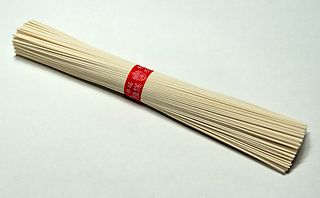 W
WKorean noodles are noodles or noodle dishes in Korean cuisine, and are collectively referred to as "guksu" in native Korean or "myeon" in Sino-Korean vocabulary. Preparations with noodles are relatively simple and dates back to around BCE 6000 to BCE 5000 in Asia. In Korea, traditional noodle dishes are onmyeon, called guksu jangguk, naengmyeon, bibim guksu, kalguksu, kongguksu among others. In royal court, baekmyeon consisting of buckwheat noodles and pheasant broth, was regarded as the top quality noodle dish. Naengmyeon, with a cold soup mixed with dongchimi and beef brisk broth, was eaten in court during summer.
 W
WCellophane noodles, or fensi, sometimes called glass noodles, are a type of transparent noodle made from starch and water. A stabilizer such as chitosan may also be used.
 W
WIn Korean cuisine, garak-guksu (가락국수) are thick wheat noodles and noodle dishes made with thick noodles.
 W
WJjolmyeon (쫄면) is either a type of Korean noodle with a very chewy texture made from wheat flour and starch, or a cold and spicy dish bibim-jjolmyeon (비빔쫄면) made with the noodles and vegetables. Jjolmyeon can add many vegetables such as cabbage and bean sprouts. The spicy and hot sauce is a combination of gochujang, vinegar, sugar, and minced garlic. It is also a type of bibim guksu.
 W
WKelp noodles or cheon sa chae, are semi-transparent noodles made from the jelly-like extract left after steaming edible kelp. They are made without the addition of grain flour or starch. Kelp noodles have a crunchy texture and are low in calories. They can be eaten raw, but for added taste, some prefer to cook them in water with spices added for flavoring.
 W
WMilmyeon is a Korean dish of long and thin noodles similar to naengmyeon, representing the dishes of Busan. The noodle is basically mixing flour powder with starches of sweet potato and potato with meat broth, which bring it and water, several kinds of vegetables to a simmer in saucepan. The mixture of flour is not fixed at certain ingredients, leading to several transformation like using Artemisia princeps for ssuk milmyeon. Milmyeon also has its variety of mul milmyeon and bibim milmyeon applicable for naengmyeon. The difference between the two is chiefly spicy sauce for bibim milmyeon.
 W
WShin Ramyun is a brand of instant noodle that has been produced by the South Korean food company Nongshim since 1 October 1986. It is now exported to over 100 countries, and is the highest selling instant noodle brand in South Korea.
 W
WSōmen , somyeon, or sùmiàn is a very thin noodle made of wheat flour, less than 1.3 mm in diameter. The noodles are used extensively in East Asian cuisines. Japanese sōmen is made by stretching the dough with vegetable oil, forming thin strands that are then air dried for later use. This is distinct from a similar thin noodle, hiyamugi, which is knife-cut.
 W
W W
W